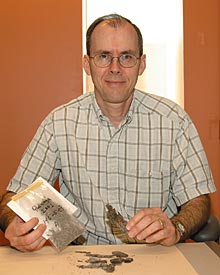  |
| HOME | THIS ISSUE | CALENDAR | GRANTS | BACK ISSUES | < BACK | NEXT > |
Ancient plant provides key evidence of climate change in Peruby Cindy Weiss - July 24, 2006 |
||||
|
The oldest flowering plant specimen - and one of the recent additions to the herbarium in the Biology Collections at UConn - is providing a key piece of evidence in a scientific paper that documents a dramatic warming trend in the high Andes of Peru. A 5,200-year-old plant specimen collected at the edge of an alpine glacier in Peru was identified by ecology and evolutionary biology professor Don Les as Distichia muscoides , a member of the rush family and a wetland plant. The plant in effect "calibrates" the new study of tropical warming, Les says, showing that more than 5,000 years ago, an alpine glacier in Peru expanded quickly in a sudden cold period. The study, published in June in the Proceedings of the National Academy of Sciences, shows an unprecedented warming trend in an alpine region of Peru for at least the past 2,000 years. Les was one of nine authors of the study, which was led by researchers at Ohio State University.
The ice had to move fast to cover the plant and preserve it, Les says. The rapid advance shows how quickly climate change can happen, he notes. The ice layer flattened the plant, but it retained enough characteristics that Les, who is the director of the herbarium at UConn, was able to identify not only its genus, but its species, which is the only one found in alpine Peru. The plant, which was radiocarbon-dated by a team of Ohio State University geologists leading the study, shows that boggy, wet conditions existed in the area before the glacier advanced.
The Ohio State researchers found the plant at the edge of the now melting ice cap and, believing it might be an aquatic plant, contacted Les, an aquatic plant expert. The plant remains that were sent to him, flattened by the ice and looking like slivers of tree bark, seemed like a long shot for identification, he says. But he noticed a specific braided pattern to the leaves, which he was able to exactly match to the rush family, and then to the species that only grows in that area of Peru, where it is still prevalent today. The specimen is now part of the George Safford Torrey Herbarium in the Biology Collections at UConn and can be seen by other scientists who want to verify the tropical warming study. The plant's characteristics can be found in the Biology's Collections online database at http://collections2.eeb.uconn.edu/collections/chp.html The plant is the oldest in the collections, which contain 175,000 plants, 750,000 specimens overall, and one of the most complete databases of any collection. The report of the Peruvian warming trend, "Abrupt Tropical Climate Change: Past and Present," appeared during the week of June 26-30 in the Proceedings of the National Academy of Sciences.
|
| ADVANCE HOME UCONN HOME |

 Three lines of evidence were used to document the warm-up: photographic records of a dramatic retreat of the Quelccaya glacier in the Andes during the period 1978 to 2000; a large increase in the amount of heavy oxygen in the ice cap during the years 1900 to 2000, which correlates with warmer conditions; and the presence of the plant identified by Les, which shows that the
climate in the area was rapidly
getting colder 5,000 years ago.
Three lines of evidence were used to document the warm-up: photographic records of a dramatic retreat of the Quelccaya glacier in the Andes during the period 1978 to 2000; a large increase in the amount of heavy oxygen in the ice cap during the years 1900 to 2000, which correlates with warmer conditions; and the presence of the plant identified by Les, which shows that the
climate in the area was rapidly
getting colder 5,000 years ago. 